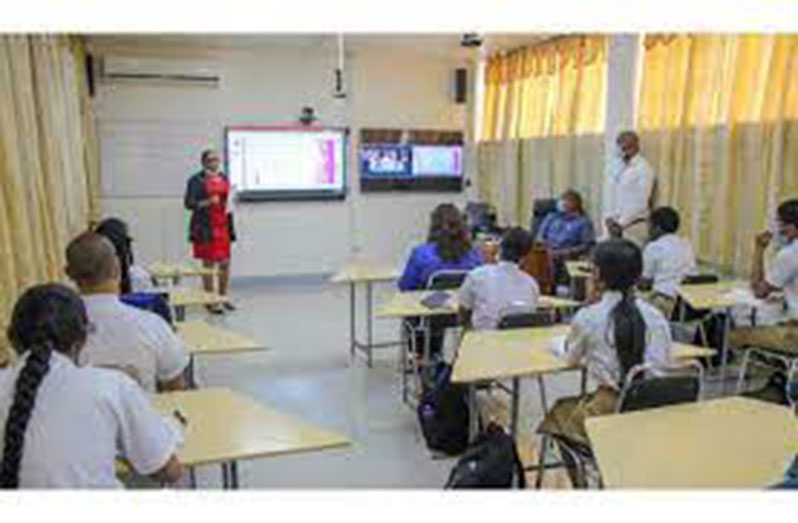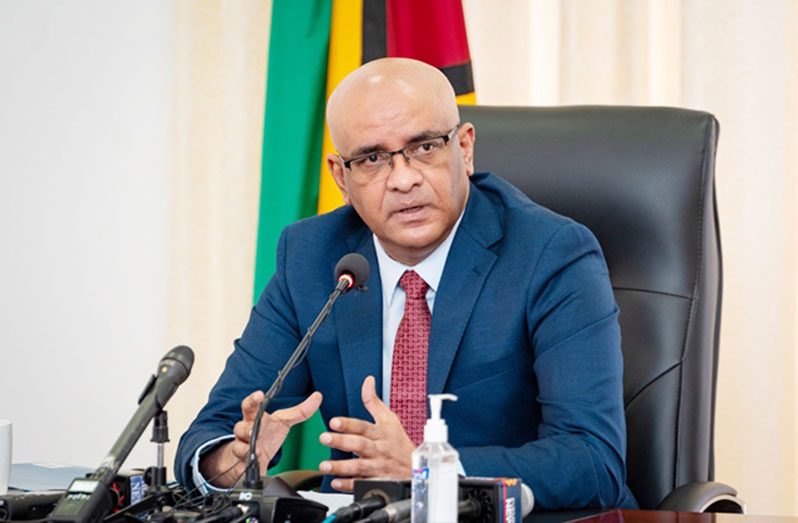— framework being crafted for Guyana’s future
— with emphasis on investment of oil funds into education, health, infrastructure and development of non-oil sectors, says Vice-President Jagdeo
IN order to solidify the foundation of Guyana’s economy and enhance the overall well-being and welfare of every Guyanese, the government is crafting a framework for development that will be sustained through prudent and effective investment of oil funds into education, health, infrastructure and the non-oil sectors.
Unlike the agenda of the former administration, especially as regards expenditure of the immense returns that will accrue to Guyana from its oil-and-gas sector, Dr Jagdeo said the intention of the incumbent is to craft a framework for the future which will see more proceeds from the petroleum industry going towards Guyanese.
“… we have to spend the money to build the future, that is why we have made it clear in our manifesto when we campaigned between 2015 and 2020, that money will be spent on education, health care, infrastructure and assistance to non-oil industries,” the Vice-President told residents of Region Six during a recent Cabinet outreach.
Those are the four areas that will attract the ‘bulk of the resources’ and are part of a broader plan to ensure that Guyana’s economy continues to thrive long after oil resources would have been exhausted.
It was reported that returns from the sector are expected to catapult Guyana to the ranks of wealthiest countries in the Western Hemisphere, thereby increasing the government’s fiscal space to invest in initiatives geared at expanding the economy and improving the overall welfare of citizens.
“Guyana is now poised to be one of the wealthiest countries in the hemisphere; we intend to employ the gains from exploiting these deposits into initiatives geared at expanding the economy, improving competitiveness, giving people the best social services, increasing productivity, enhancing food production, and building new sectors,” President Dr. Irfaan Ali had said in his keynote address during a virtual faculty workshop on the microeconomics of competitiveness hosted by the Harvard Business School.

In painting a vivid image of what is expected of the oil-and-gas sector in the near term, Dr.Ali said that by 2025, operating cash flow, based on total investment, is expected to reach US$3.5 billion.
As it is now, Guyana has US$719,713,039 in its Natural Resources Fund (NRF) at the US Federal Reserve Bank.
The government, since being elected to office in 2020, has only this year, budgeted to utilise some of those funds. Its landmark $552 billion budget, which is 44.3 per cent larger than Budget 2021, includes roughly $126.7 billion from the NRF.
This decision was taken by the government only after the enactment of a new and strengthened legislative framework governing the 2021 Natural Resources Fund (NRF) Act.
“We have come up with a simple, transparent formula for transferring money from the Natural Resources Fund to the budget, and we have outlined the four areas in which we would utilise this money,” Dr. Jagdeo told the business community in Region Six.
INVESTMENTS ALREADY MADE
Despite not utilising any of the oil funds, the government has still been able to initiate the process of strengthening the four pillars of development, according to the Vice-President.
On the topic of education, the government has increased the education cash grant from $15,000 to $25,000 and the uniform voucher from $4,000 to $5,000. This initiative benefits each school-aged child from both the public and private school systems.
The overarching objective, according to Dr Jagdeo, is to increase the education cash grant to $50,000 per month within five years.
Further, the government plans to award some 20,000 online scholarships to persons through the Guyana Online Academy of Learning (GOAL). And of this amount, 6,000 were already awarded and 500 of those beneficiaries are from Region Six.

Additionally, for those persons who cannot get into the programme, there is a three-month course that, once completed, would afford persons entry into either a tertiary-level programme or a specialised technical programme.
This, Dr Jagdeo said, is all part of a plan to equip Guyanese with the knowledge and technical expertise to meet the skills demand Guyana will need in the near future.
“If we educate our people, whether in oil and gas or another area, they would be able to earn more and we would equip them to work in any industry,” the Vice-President said.
To achieve this goal, the government will also be transforming the Port Mourant Training Centre into a national institute for oil and gas and hospitality.
All those programmes are supplemented by the Local Content Act that came into effect in December 2021.
The new law earmarks 40 sectors or services and stipulates a minimum percentage of the total value of expenditure on those services that oil companies and their sub-contractors must procure from Guyanese suppliers.
In essence, this law creates a foundation for Guyanese to complete the various technical and academic programmes and acquire a job with little to no hassle.
Aside from job security, the government intends to establish the ideal conditions for business, especially manufacturing, and decrease the general cost of living by investing in an energy mix that will reduce the cost of electricity by approximately 50 per cent.
Specifically, this would be achieved through the Gas-to-Energy Project, the Amaila Falls Hydropower Project and the establishment of solar farms across Guyana.
Other transformational projects are also in the pipeline and those include the construction of several hospitals and diagnostic centres and the construction and enhancement of roads and bridges, among others.




.jpg)










